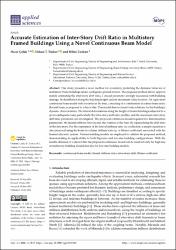| dc.contributor.author | Çolak, Hacer | |
| dc.contributor.author | Türker, Hakan T. | |
| dc.contributor.author | Coşkun, Hilmi | |
| dc.date.accessioned | 2024-01-05T07:18:53Z | |
| dc.date.available | 2024-01-05T07:18:53Z | |
| dc.date.issued | 2023 | en_US |
| dc.identifier.citation | Çolak, H., Türker, H.T., Coşkun, H. (2023). Accurate Estimation of Inter-Story Drift Ratio in Multistory Framed Buildings Using a Novel Continuous Beam Model. Applied Sciences (Switzerland), 13 (13), art. no. 7819.
https://doi.org/10.3390/app13137819 | en_US |
| dc.identifier.issn | 2076-3417 | |
| dc.identifier.uri | https://doi.org/10.3390/app13137819 | |
| dc.identifier.uri | https://hdl.handle.net/20.500.12508/2911 | |
| dc.description.abstract | This study presents a novel method for accurately predicting the dynamic behavior of multistory frame buildings under earthquake ground motion. The proposed method allows approximately estimating the inter-story drift ratio, a crucial parameter strongly associated with building damage, its distribution along the building height, and its maximum value location. An equivalent continuous beam model with a rotation at the base, consisting of a combination of a shear beam and a flexural beam, is proposed to achieve this. This model derives closed-form solutions for the building's dynamic characteristics. The lateral deformations along the height of frame buildings subjected to a given earthquake load, particularly the inter-story drift ratio profiles, and the maximum inter-story drift ratio parameter, are investigated. The proposed continuous model requires two dimensionless parameters: the lateral stiffness ratio (& alpha;) and the rotation at the base (& theta;), representing the drift ratio of the first story. For the expression of the lateral stiffness ratio (& alpha;) coefficient, a simple equation is also proposed using the beam-to-column stiffness ratio (& rho;, or Blume coefficient) associated with the framed (discrete) system. Various building models are employed to validate the proposed method, demonstrating its applicability to both high-rise and low-rise building configurations. With the results obtained, it is shown that the proposed continuous model can be used not only for high-rise or multistory building models but also for low-rise building models. | en_US |
| dc.language.iso | eng | en_US |
| dc.publisher | MDPI | en_US |
| dc.relation.isversionof | 10.3390/app13137819 | en_US |
| dc.rights | info:eu-repo/semantics/openAccess | en_US |
| dc.subject | Blume coefficient | en_US |
| dc.subject | Continuous beam model | en_US |
| dc.subject | Inter-story drift | en_US |
| dc.subject | Lateral stiffness ratio | en_US |
| dc.subject.classification | Engineering & Materials Science
- Concrete Science
- Reinforced Concrete | |
| dc.subject.classification | Near | |
| dc.subject.classification | Seismic Response | |
| dc.subject.classification | Cable-Stayed Bridge | |
| dc.subject.other | Floor acceleration demands | |
| dc.subject.other | Shear | |
| dc.subject.other | Spectrum | |
| dc.subject.other | Stiffness | |
| dc.subject.other | Height | |
| dc.title | Accurate Estimation of Inter-Story Drift Ratio in Multistory Framed Buildings Using a Novel Continuous Beam Model | en_US |
| dc.type | article | en_US |
| dc.relation.journal | Applied Sciences (Switzerland) | en_US |
| dc.contributor.department | Mühendislik ve Doğa Bilimleri Fakültesi -- İnşaat Mühendisliği Bölümü | en_US |
| dc.identifier.volume | 13 | en_US |
| dc.identifier.issue | 13 | en_US |
| dc.relation.publicationcategory | Makale - Uluslararası Hakemli Dergi - Kurum Öğretim Elemanı | en_US |
| dc.contributor.isteauthor | Coşkun, Hilmi | |
| dc.relation.index | Web of Science - Scopus | en_US |
| dc.relation.index | Web of Science Core Collection - Science Citation Index Expanded | |
















